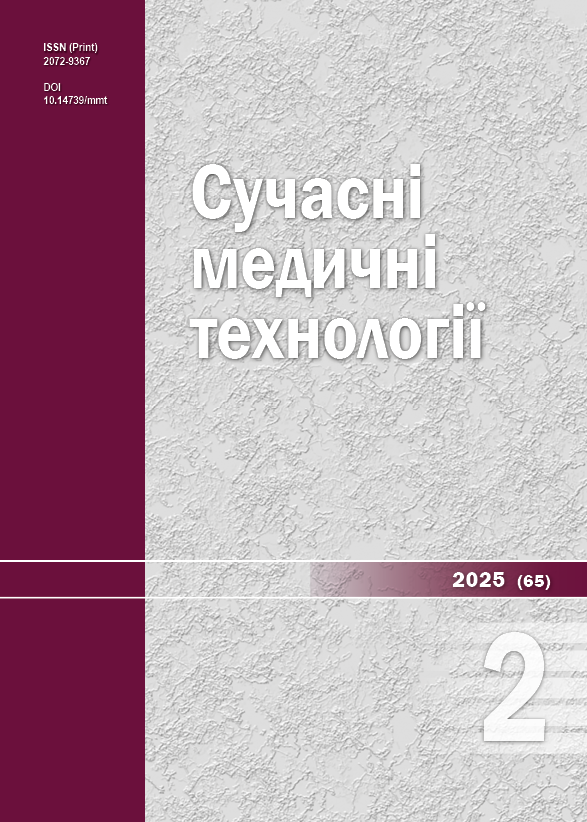Emergency thyroidectomy for poorly controlled hyperthyroidism in the context of war in Ukraine
DOI:
https://doi.org/10.14739/mmt.2025.2.322358Keywords:
hyperthyroidism, Graves’ disease, urgent care, thyroidectomyAbstract
The aim of the work is to analyze the results of surgical treatment of patients with hyperthyroidism (Graves’ disease, multinodular toxic goiter, solitary toxic adenomas) in patients who were observed during the period of hostilities in Ukraine.
Materials and methods. The retrospective study included 70 patients operated on for hyperthyroidism in the surgical clinic of the MNE “Kyiv City Clinical Hospital No. 8” during the period of military operations in 2022–2024. All patients underwent a comprehensive clinical and instrumental examination, an assessment of the clinical manifestations of the disease was carried out depending on the wartime migration, the nature of surgical treatment, and the immediate results of the postoperative period. Laryngeal dysfunction, hypocalcemia, hematoma, and bleeding were recorded. All samples of the removed thyroid glands underwent pathological analysis. Data analysis was performed using statistical methods.
Results. Observations of wartime patients showed that unstable, poorly controlled hyperthyroidism in Graves’ disease was more common in people from frontline regions and in evacuated patients. In our observations, 32 (45.7 %) patients required urgent surgery for poorly controlled hyperthyroidism. Planned surgery for well-controlled hyperthyroidism was performed in 38 (54.3 %) patients.
Conclusions. Surgical intervention is the method of choice for rapid final control of hyperthyroidism in Graves’ disease, multinodular toxic goiter, and toxic adenoma. During the period of military operations in Ukraine, patients with hyperthyroidism were predominantly Graves’ disease patients who could not achieve stable drug compensation of thyrotoxicosis, which was an indication for urgent thyroidectomy. Urgent surgical intervention for hyperthyroidism can be safely performed when using effective protocols for accelerated preoperative preparation.
References
Barczyński M. Current approach to surgical management of hyperthyroidism. Q J Nucl Med Mol Imaging. 2021;65(2):124-31. doi: https://doi.org/10.23736/S1824-4785.21.03330-6
Lee SY, Pearce EN. Hyperthyroidism: A Review. JAMA. 2023;330(15):1472-83. doi: https://doi.org/10.1001/jama.2023.19052
Usenko OY, Khomenko IP, Kovalenko AY, Halochka IP, Kovalchuk OI. [Stress-induced diseases of the thyroid gland in Ukraine during hostilities]. Modern medical technology. 2023;(3):31-6. Ukrainian. doi: https://doi.org/10.34287/MMT.3(58).2023.5
Xu T, Zheng X, Wei T. Preoperative preparation for Graves’ disease. Front Endocrinol (Lausanne). 2023 Aug 23;14:1234056. doi: https://doi.org/10.3389/fendo.2023.1234056
Hall AJ, Topliss DJ. Medical and surgical treatment of thyroid eye disease. Intern Med J. 2022;52(1):14-20. doi: https://doi.org/10.1111/imj.15067
Cohen O, Ronen O, Khafif A, Rodrigo JP, Simo R, Pace-Asciak P, et al. Revisiting the role of surgery in the treatment of Graves’ disease. Clin Endocrinol (Oxf). 2022;96(6):747-57. doi: https://doi.org/10.1111/cen.14653
Gunn AH, Frisco N, Thomas SM, Stang MT, Scheri RP, Kazaure HS. Patient-Reported Outcomes Following Total Thyroidectomy for Graves’ Disease. Thyroid. 2022;32(1):54-64. doi: https://doi.org/10.1089/thy.2021.0285
Liang JJ, Irizarry R, Victor LS, Hoepner LA, Chernichenko N. Postoperative Complications After Total Thyroidectomy for Patients With Graves’ Disease. Otolaryngol Head Neck Surg. 2023;168(4):754-60. doi: https://doi.org/10.1177/01945998221108050
Song Z, Akhund R, Wu C, Wang R, Lindeman B, Fazendin J, et al. From routine to rescue: Thyroidectomy for life-threatening thyrotoxicosis. World J Surg. 2024;48(12):2892-8. doi: https://doi.org/10.1002/wjs.12312
Hedberg F, Falhammar H, Calissendorff J, Bränström R. Surgical outcome after thyroidectomy due to Graves’ disease and Lugol iodine treatment: a retrospective register-based cohort study. Endocrine. 2024;85(1):272-8. doi: https://doi.org/10.1007/s12020-024-03708-4
De Almeida R, McCalmon S, Cabandugama PK. Clinical Review and Update on the Management of Thyroid Storm. Mo Med. 2022;119(4):366-71.
Ross DS. Is the Risk of Thyroid Storm Higher When Patient-Related Factors Delay Treatment of Hyperthyroidism, Or Is It Higher When Patients Undergo Thyroidectomy While Still Thyrotoxic? Thyroid. 2023;33(6):664-5. doi: https://doi.org/10.1089/thy.2023.0086
Kartal B, Dural AC, Aydin H, Sahbaz NA, Guzey D, Kaya A, et al. Comparison of urgent and elective thyroidectomy complications in Graves’ disease. Ann Ital Chir. 2022;92:286-93.
Fazendin J, Zmijewski P, Allahwasaya A, McLeod C, Akhund R, Gillis A, et al. Surgical Treatment of Hyperthyroidism Can Be Performed Safely Before a Euthyroid State is Achieved. Thyroid. 2023;33(6):691-6. doi: https://doi.org/10.1089/thy.2022.0392
Downloads
Additional Files
Published
How to Cite
Issue
Section
License
Copyright (c) 2025 S. I. Savoliuk, A. Ye. Kovalenko, A. V. Zabronskyi

This work is licensed under a Creative Commons Attribution-NonCommercial 4.0 International License.
The work is provided under the terms of the Public Offer and of Creative Commons Attribution-NonCommercial 4.0 International (CC BY-NC 4.0). This license allows an unlimited number of persons to reproduce and share the Licensed Material in all media and formats. Any use of the Licensed Material shall contain an identification of its Creator(s) and must be for non-commercial purposes only.














